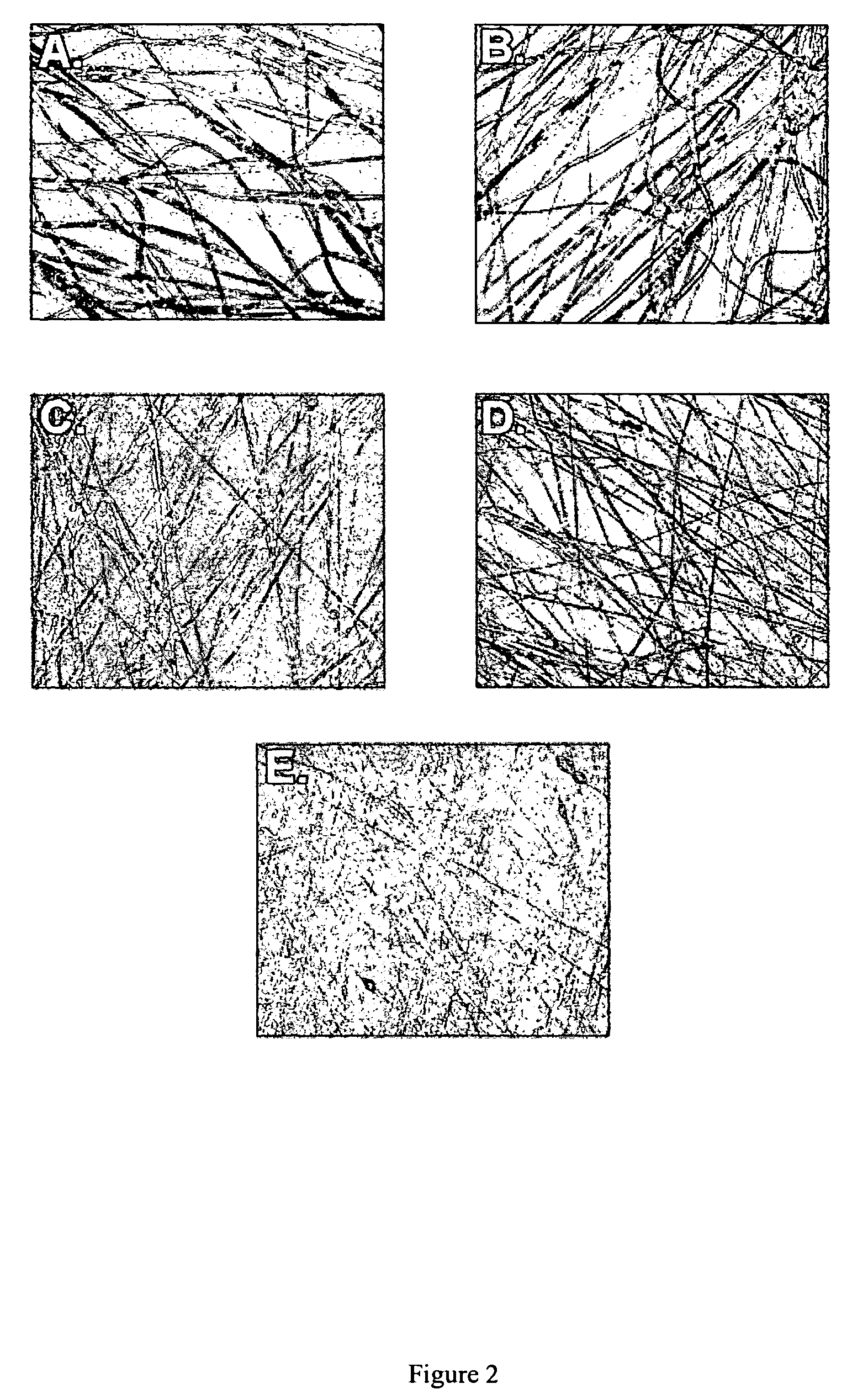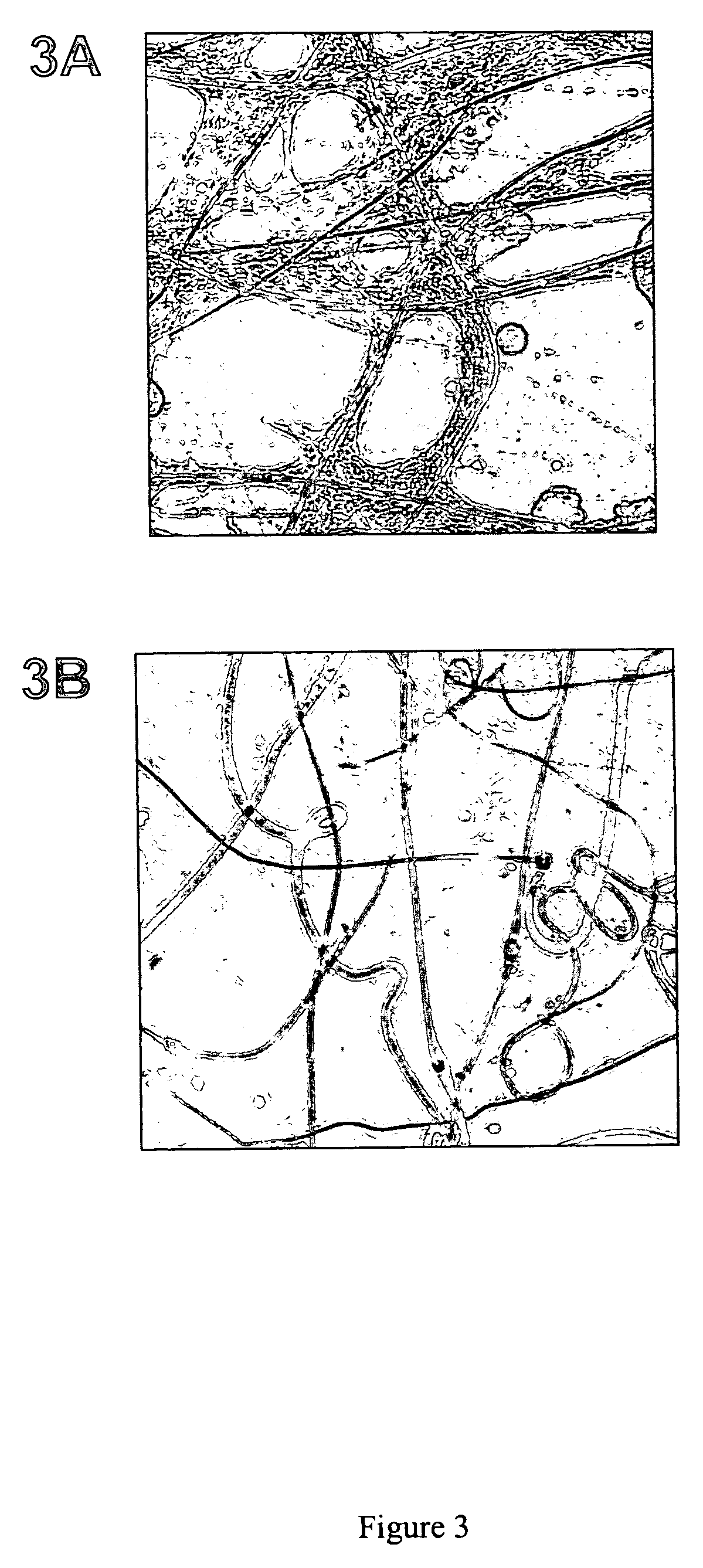Nanofibrillar structure and applications including cell and tissue culture
a technology of nanofibers and nanofibers, applied in the field of nanofibers for cell culture and tissue engineering, can solve the problems of multiple layers of fine fibers, lack of an environment for living cells growth, and limited efforts
- Summary
- Abstract
- Description
- Claims
- Application Information
AI Technical Summary
Benefits of technology
Problems solved by technology
Method used
Image
Examples
example 1
Electrospinning a Polymer Solution Comprising a Lipid Produces an Enhanced Population of Thin Fibers
[0148]To visualize the changes in fiber diameter associated with the addition of a lipid to a polymer solution using an optical microscope, fibers were electrospun to obtain microfibers. Microfibers were electrospun from a solution comprising 15% poly(ε-caprolactone) (w / w) in chloroform supplemented with (Dow Tone Polymers, Midland, Mich.) 0, 0.25, 0.5, 1.0 and 1-% respectively of cholesterol (w / w) (Sigma, St. Louis, Mo.). The fibers were electrospun using a capillary needle system. An Eppendorf micropipette tip (yellow) was fitted to a 5 cc syringe. The polymer solution was poured into the syringe and a positive electrode connected to a Nanosecond Optical Pulse Radiator Model NR-1 (Optitron, Inc., Torrance, Calif.) was inserted into the solution. The electrospinning voltage was 18,000 volts. The fibers were electrospun onto a grounded metal plate target spinning in a plane perpendicu...
example 2
Nanofibers Comprising a Lipid Induce Tight Attachment of Cells to the Nanofiber
[0150]Nanofibers comprising a lipid provide a surface that promotes recruitment of cells and tight association between the cells and nanofibers. Normal kidney rat (NRK) fibroblasts were cultured on nanofibers electrospun from a solution comprising 10% poly(ε-caprolactone) (w / w) in chloroform supplemented with 0.25% sphingomyelin in Dulbecco Modified Eagle's Medium (DME) at 37° C. in 5% CO2 and visualized on a light microscope (Insight Bilateral Scanning Confocal Fluorescence Microscope (Meridian Instruments, Okemos, Mich.)) with a 20× objective. Images were captured with a CCD camera.
[0151]As shown in FIGS. 3A and B, nanofibers comprising 0.25% sphingomyelin induce a rapid recruitment of cells and their attachment to the nanofibers. FIG. 3A shows NRK fibroblasts after two days of culture on a tissue culture plate coated with nanofibers comprising 0.25% sphingomyelin. The fibroblasts are tightly attached t...
example 3
Cells Grown on Nanofiber Network have Actin Networks Similar to Cells within Tissue
[0152]The actin network of a cell has been utilized as a marker to determine which cell culture methods most closely approximate the environments within tissues (Cukierman et al., 2001, Science, 23:1708-1712; Walpita and Hay, 2002, Nature Rev. Mol. Cell. Biol., 3:137-141). When grown in two-dimensional tissue culture, fibroblasts assume a highly spread and adhering morphology in which the actin network located within the cytoplasm is organized into arrays of thick stress fibers. In contrast, fibroblasts observed in tissues are spindle-like in shape with actin organized in a cortical ring (Walpita and Hay, 2002, Nature Rev. Mol. Cell. Biol., 3:137-141).
[0153]We compared the actin network of normal rat kidney (NRK) fibroblasts grown on two-dimensional and three-dimensional surfaces. Fibroblasts were grown on polyamide nanofiber network, glass, and glass coated with polylysine. The polyamide nanofibers w...
PUM
| Property | Measurement | Unit |
|---|---|---|
| diameter | aaaaa | aaaaa |
| diameter | aaaaa | aaaaa |
| thickness | aaaaa | aaaaa |
Abstract
Description
Claims
Application Information
 Login to View More
Login to View More - R&D
- Intellectual Property
- Life Sciences
- Materials
- Tech Scout
- Unparalleled Data Quality
- Higher Quality Content
- 60% Fewer Hallucinations
Browse by: Latest US Patents, China's latest patents, Technical Efficacy Thesaurus, Application Domain, Technology Topic, Popular Technical Reports.
© 2025 PatSnap. All rights reserved.Legal|Privacy policy|Modern Slavery Act Transparency Statement|Sitemap|About US| Contact US: help@patsnap.com



